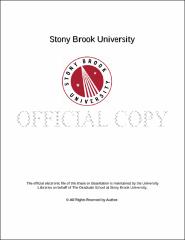| dc.identifier.uri | http://hdl.handle.net/11401/77000 | |
| dc.description.sponsorship | This work is sponsored by the Stony Brook University Graduate School in compliance with the requirements for completion of degree. | en_US |
| dc.format | Monograph | |
| dc.format.medium | Electronic Resource | en_US |
| dc.language.iso | en_US | |
| dc.publisher | The Graduate School, Stony Brook University: Stony Brook, NY. | |
| dc.type | Dissertation | |
| dcterms.abstract | Modulation of the central neural control system governing breathing is a critical mechanism for maintaining homeostasis of a functioning physiological system. Perturbations can be either endogenous or exogenous to the respiratory control system, meaning there are factors that modulate the respiratory control centers either directly (endogenously) or indirectly via feedback mechanisms (exogenously). We hypothesized that perturbations to the neural controller would cause changes in the configuration of the neural network, as evidenced by changes in slow and fast oscillatory respiratory network dynamics. To test this hypothesis, we use both an in vitro and an in vivo rat experimental preparation in conjunction with perturbations to disrupt homeostasis endogenously and exogenously. In the in vitro preparation, we perturbed the respiratory system endogenously by changing either the temperature or the K+ concentration of the artificial cerebral spinal fluid. In the in vivo preparation, we perturbed the system exogenously by eliciting sneeze or micturition reflexes. We analyzed neurogram and/or electromyogram activity data from multiple respiratory-related outputs to characterize and quantify timing, patterning, and phase-related variability between respiratory outputs in order to gain insight on how the brainstem is reorganized to intrinsically modulate control of the diaphragm and upper airways. Both endogenous and exogenous perturbations altered the neural network resulting in modulation of various aspects of respiratory-related discharge. Endogenous perturbations modified the respiratory network components that govern respiratory burst generation and the relationship between respiratory outputs, but respiratory rhythm was uninterrupted. Moreover, endogenously-mediated changes in excitability produced same direction changes in the synchrony or orderliness of the network. In contrast, exogenous perturbations modified respiratory network components that generate respiratory rhythm resulting in a disruption of fundamental underlying respiratory behavior, which was evident by the production of dysrhythmia and altered phase-timing between different respiratory-related outputs. In conclusion, the respiratory network is dynamic on a breath-to-breath basis and reconfigures to maintain a functional physiological system. | |
| dcterms.available | 2017-09-20T16:51:37Z | |
| dcterms.contributor | Moore, Leon | en_US |
| dcterms.contributor | Entcheva, Emilia | en_US |
| dcterms.contributor | Solomon, Irene C | en_US |
| dcterms.contributor | Collins, William | en_US |
| dcterms.contributor | Canning, Brendan. | en_US |
| dcterms.creator | Shen, Tabitha | |
| dcterms.dateAccepted | 2017-09-20T16:51:37Z | |
| dcterms.dateSubmitted | 2017-09-20T16:51:37Z | |
| dcterms.description | Department of Biomedical Engineering. | en_US |
| dcterms.extent | 83 pg. | en_US |
| dcterms.format | Monograph | |
| dcterms.format | Application/PDF | en_US |
| dcterms.identifier | http://hdl.handle.net/11401/77000 | |
| dcterms.issued | 2015-08-01 | |
| dcterms.language | en_US | |
| dcterms.provenance | Made available in DSpace on 2017-09-20T16:51:37Z (GMT). No. of bitstreams: 1
Shen_grad.sunysb_0771E_12214.pdf: 1166208 bytes, checksum: 27557b9202a2f482f6d580c93954b737 (MD5)
Previous issue date: 2014 | en |
| dcterms.publisher | The Graduate School, Stony Brook University: Stony Brook, NY. | |
| dcterms.subject | Micturition, Potassium, Respiration, Temperature | |
| dcterms.subject | Biomedical engineering | |
| dcterms.title | Modulation of Rodent Central Respiratory Network Dynamics and Respiratory Phase Interactions | |
| dcterms.type | Dissertation | |

